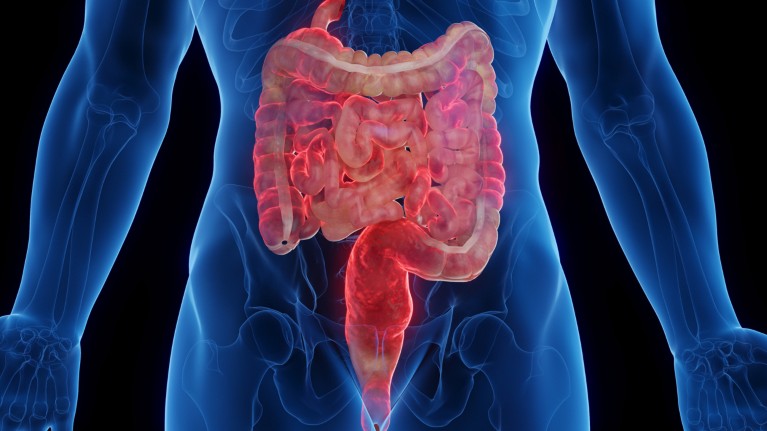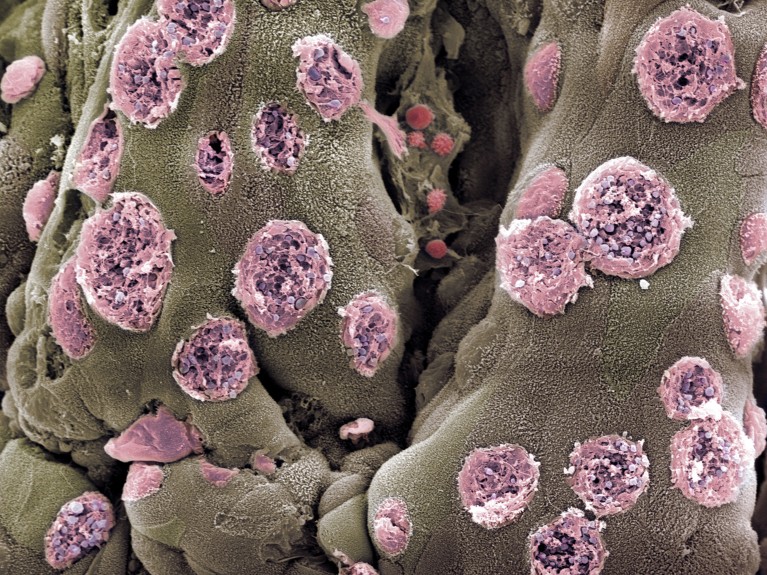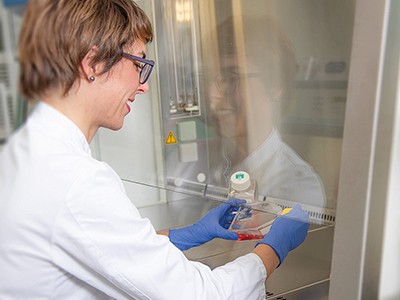
Crohn’s disease, a form of inflammatory bowel disease, often affects the intestines (artist’s illustration).Credit: Sebastian Kaulitzki/Science Photo Library
When geneticist James Lee and his colleagues published a paper in June linking a gene to inflammatory bowel disease (IBD), he didn’t expect the public to take much notice. Things did not go as planned.
“I got inundated,” he says.
By the end, Lee did more than 25 interviews for radio and print outlets around the world and received hundreds of e-mails from people with IBD. “It’s a testament to how common inflammatory bowel disease is,” says Lee, who works at the Francis Crick Institute in London. “And also a testament to how desperate people are for better treatments.”
Lee’s paper, published in Nature1, is one of several recent reports offering hope that people with IBD could one day have better treatment options tailored to their disease. Lee and his colleagues found that changes in the activity of a gene that is important in the immune system could contribute to some cases of the disease. Another study found that some people with IBD make antibodies that disable a pivotal anti-inflammatory protein2 and a third study tracked how populations of gut bacteria adapt to an inflamed environment3.
The papers look at IBD from different angles, but together offer a glimpse into the ways that physicians might one day be able to better match people with IBD to appropriate treatments, says David Artis, an immunologist at Weill Cornell Medicine in New York City. “Not every inflammatory bowel disease patient who walks in the door is the same,” he says. “If we can map that difference to some extent, I think we’re going to be able to better treat those people.”
Life-altering diseases
IBD is a painful condition that causes chronic inflammation of the digestive tract. Two of the most common forms of IBD are ulcerative colitis and Crohn’s disease. Both can cause diarrhoea, anaemia and abdominal cramping.
Like many autoimmune disorders, IBD has an aetiology that is murky and complex, with contributions from both genetics and the environment. What is clear is that incidence of the disease is rising in many regions of the world4.
Over the past decade, researchers have amassed a lengthy list of genetic variations that are linked to IBD. But Lee and his colleagues decided to examine a region of the genome where few geneticists had bothered to look: a “gene desert”, says Lee, so named because it is devoid of any recognizable genes. “We didn’t know what we were going to find,” he says. “And we ended up finding a master regulator of inflammatory responses.”

Mucus-producing cells (pink; artificially coloured) stud the intestines of a person with ulcerative colitis, a common form of inflammatory bowel disease.Credit: Steve Gschmeissner/Science Photo Library
This master regulator is a stretch of DNA that controls the activity of a gene called ETS2, which is located far away from the gene desert. High levels of ETS2 activity, the team found, boost the ability of immune cells called macrophages to promote inflammation.
The finding also indicated that a class of cancer drugs called MEK inhibitors might prevent the activation of ETS2. The team found that these drugs could block the effects of the ETS2 protein, including the release of inflammation-promoting molecules, in cells grown in the laboratory. But MEK inhibitors can become toxic to other cells if given over the long term, says Lee, and so the team is developing ways to deliver the inhibitors only to macrophages before testing the approach in people with IBD.
Rogue antibodies
Another study has found a select group of people with IBD who might have a new therapeutic option in the near future. Paediatric immunologist Sophie Hambleton at Newcastle University in Newcastle upon Tyne, UK, and her colleagues analysed samples from two children with IBD. The scientists discovered that the children were producing antibodies that block the activity of a protein called IL-102. This protein has anti-inflammatory effects in the gut.
But the children’s antibodies meant that IL-10 was unable to dampen inflammation in their intestines, leading to IBD, the researchers reported in July in the New England Journal of Medicine. Once the link between IL-10 and their disease was identified, one of the children was treated with therapies to deplete the antibodies, easing their symptoms.
It’s unclear how many people with IBD make antibodies against their own IL-10, says Hambleton. But when the team looked at a sample of adults with IBD, they found “a clear minority” who also produced the antibodies. “We are very confident that this is going to be a contributory mechanism in more patients,” she says.
Microbiome reaction
In addition to genetics and immune cells, microorganisms are thought to play a part in IBD. In the third study, Christopher Smillie, who studies the human microbiome at Harvard Medical School in Boston, Massachusetts, and his colleagues, looked at how chronic inflammation shapes evolution of the microorganisms living in the digestive track3.
Gut feeling yields evidence of microbial involvement in autoimmunity
They identified 140,000 bacterial strains in stool samples from people with and without IBD. Hundreds of these strains were associated with IBD, and many appear to have adapted to living in inflamed tissue. Among those, several could be used to predict disease severity: for example, the abundance of some strains of Eggerthella lenta declined as the levels of a protein associated with inflammation rose. The results were published in Cell Host & Microbe in July.
Ultimately, Smillie hopes that characterization of these microorganisms will lead to ways to monitor disease progression, and to sort people with IBD into groups on the basis of how likely they are to respond to potential therapies.
Each of these studies could contribute to that goal, but the work is still preliminary, says Gabriel Nuñez, an immunologist at the University of Michigan Medical School in Ann Arbor. For example, the microbial study does not show that any of these organisms contribute to disease, he notes. And it is unclear what proportion of people with IBD have altered ETS2 activity or make autoantibodies against IL-10. “Perhaps these are rare patients, and only a handful in the world will benefit,” he says.
Nevertheless, if only a handful of people find relief because of these results, that will be progress, he adds. “Even if you cure only one patient, it’s important for that person and their family.”


